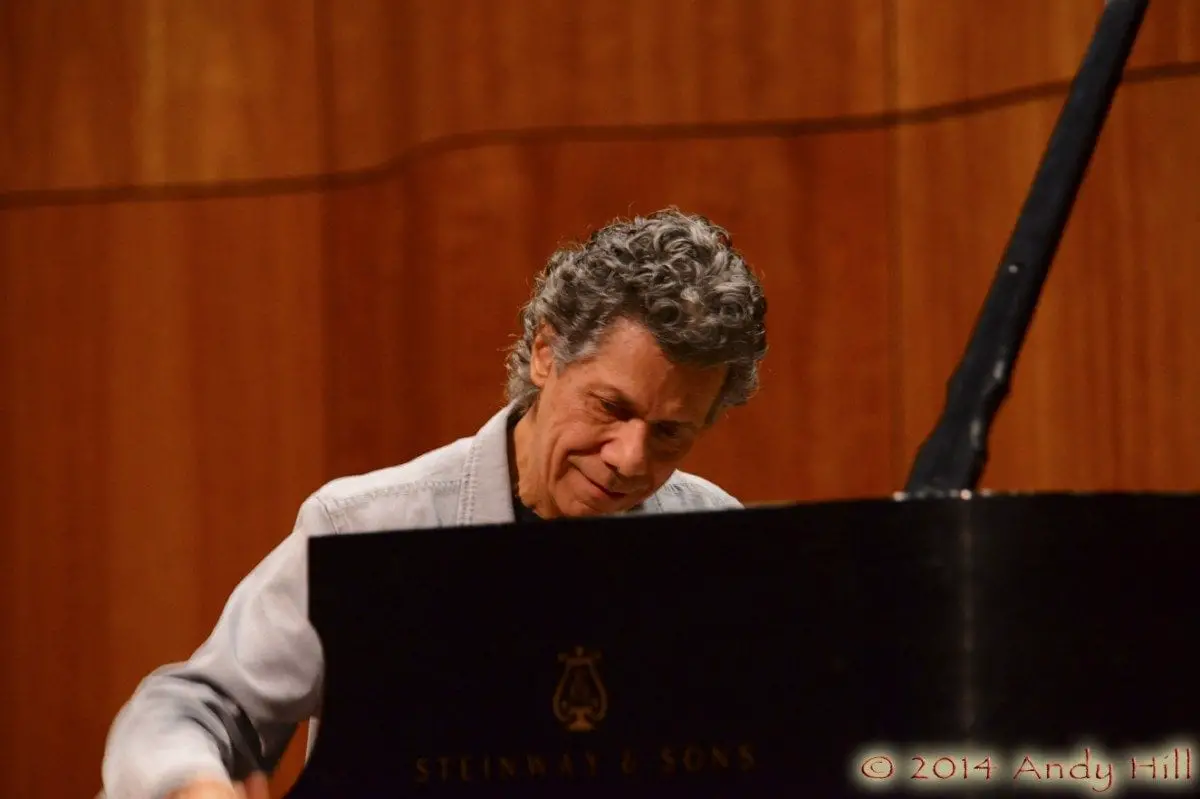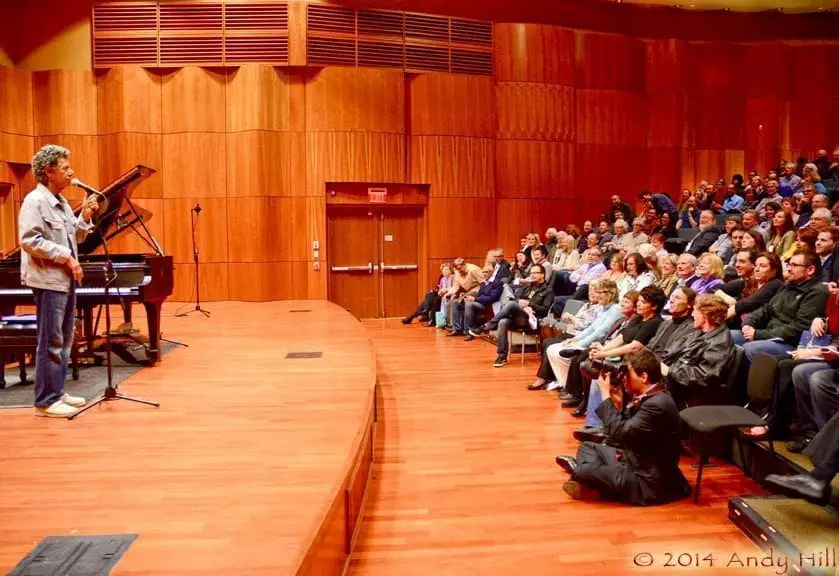The Massry Center for the Arts played host to yet another legend of American music, bringing Chick Corea to the stage of the Picotte Recital Hall on April 11th. The venue has played host to Soulive, Chris Thile, John Medeski, B.B. King and numerous classical performances in its brief six-year history, putting the yearly calendar on par with The Egg when it comes to spectacular music in a state of the art performance space. Speaking with a Boston brogue meets Manhattan accent, Chick sounded a bit like Vermont Senator Bernie Sanders, passionate and thorough in his insight into the music of the evening.
 On this evening, Chick Corea used but did not need the microphone to address the sold out crowd, for the venue’s acoustics allowed for his voice to echo throughout the entirety of the Hall. Coming out unannounced, Corea spoke of attending Saint Rose church while growing up in Chelsea, Massachusetts, referencing the collegiate campus of The Massry. He spoke of leaving Massachusetts for New York City, so he could be with his musical heroes, many of whom he performed the work of this evening. Opening with “It Could Happen to You”, recorded by Miles Davis, his fingers glided across the Steinway & Sons piano, followed by an introducing the crowd to Stan Getz “Desafinado” and played bossa nova on the piano.
On this evening, Chick Corea used but did not need the microphone to address the sold out crowd, for the venue’s acoustics allowed for his voice to echo throughout the entirety of the Hall. Coming out unannounced, Corea spoke of attending Saint Rose church while growing up in Chelsea, Massachusetts, referencing the collegiate campus of The Massry. He spoke of leaving Massachusetts for New York City, so he could be with his musical heroes, many of whom he performed the work of this evening. Opening with “It Could Happen to You”, recorded by Miles Davis, his fingers glided across the Steinway & Sons piano, followed by an introducing the crowd to Stan Getz “Desafinado” and played bossa nova on the piano.
 Corea then asked the crowd, “Would you like to hear something by John Coltrane?”, and he then proceeded to play a track from Village Vanguard, off his phone, into the mic, for a solid 30 seconds, with laughs and applause from all. No one complained about this, and it lightened up the evening even more. Chick Corea was not looking for a night of serious, focused performance, but one where he interacted with the audience and kept things light. Two Bill Evans numbers followed, “Song #1” and “Very Early”, the latter a serenading waltz.
Corea then asked the crowd, “Would you like to hear something by John Coltrane?”, and he then proceeded to play a track from Village Vanguard, off his phone, into the mic, for a solid 30 seconds, with laughs and applause from all. No one complained about this, and it lightened up the evening even more. Chick Corea was not looking for a night of serious, focused performance, but one where he interacted with the audience and kept things light. Two Bill Evans numbers followed, “Song #1” and “Very Early”, the latter a serenading waltz.
 Remarking that Thelonius Monk was the “most profound jazz composer,” he treated the audience to “Pannonica,” elegant and melodic, and “Work,” plucking the internal strings for an added, deep bass sound and a highlight of the evening. Continuing with tributes to those he admired and called friends, he spoke of Stevie Wonder, who he first met in 1972/1973 at The Bitter End in New York City. Having recently discussed American standard songs, such as “My Funny Valentine,” Stevie said to him “What about new standards, like my music?” Donning a flannel shirt, Chick played “Overjoyed” and “Pastime Paradise,” which found audience members mouthing the lyrics to two classic Wonder songs.
Remarking that Thelonius Monk was the “most profound jazz composer,” he treated the audience to “Pannonica,” elegant and melodic, and “Work,” plucking the internal strings for an added, deep bass sound and a highlight of the evening. Continuing with tributes to those he admired and called friends, he spoke of Stevie Wonder, who he first met in 1972/1973 at The Bitter End in New York City. Having recently discussed American standard songs, such as “My Funny Valentine,” Stevie said to him “What about new standards, like my music?” Donning a flannel shirt, Chick played “Overjoyed” and “Pastime Paradise,” which found audience members mouthing the lyrics to two classic Wonder songs.
A break from 20th century musicians brought Corea back to 19th century composer Frédéric Chopin, performing the Polish composer’s “Matzurka in A Minor, Op 17 No 4”; regardless of familiarity with the piece, all took great pleasure in this beautiful classical selection. Corea then took a step back, raised his hands to the piano in thanks and took a short break to allow the piano to be briefly tuned. He strolled back out to the stage 15 minutes later, unannounced, and casually waited for the audience, even taking a moment to answer a pronunciation question on Monk’s “Epistrophy”. The final cover of the night was the late Paco de Lucia’s “The Yellow Numbus”, with each hand playing two distinct melodies, intertwining the Spanish influence of the late de Lucia along the journey.
 “I have an idea,” said Corea. He wanted to create portraits, also the title of his latest double album, chock full of solo performances. He invited audience members who were interested to come down and have a seat next to the piano while he improvised their ‘portrait’, much as a visual artist might do, but in this case, his medium was the piano. Four audience members were given a rare treat – a personal composition based on nothing more than their name and appearance.
“I have an idea,” said Corea. He wanted to create portraits, also the title of his latest double album, chock full of solo performances. He invited audience members who were interested to come down and have a seat next to the piano while he improvised their ‘portrait’, much as a visual artist might do, but in this case, his medium was the piano. Four audience members were given a rare treat – a personal composition based on nothing more than their name and appearance.
 Portrait #1 was for Nancy, a Kindergarten teacher, a lovely number that seemed to combine the theme to ‘Mr. Rogers Neighborhood” and springtime. Portrait #2 for Richard in his off-white suit had a Billy Joel mid-70s vibe. Portrait #3 for Lorena ‘from the mountains’ (Inlet, NY), sounded like Glassworks #4 and was truly gorgeous. The fourth and final portrait was for an audience member most were familiar with, Jim Kambrich from WNYT, whose Portrait started out in the vein of Walt Disney’s The Old Mill (1937), with a fresh, light and airy ending.
Portrait #1 was for Nancy, a Kindergarten teacher, a lovely number that seemed to combine the theme to ‘Mr. Rogers Neighborhood” and springtime. Portrait #2 for Richard in his off-white suit had a Billy Joel mid-70s vibe. Portrait #3 for Lorena ‘from the mountains’ (Inlet, NY), sounded like Glassworks #4 and was truly gorgeous. The fourth and final portrait was for an audience member most were familiar with, Jim Kambrich from WNYT, whose Portrait started out in the vein of Walt Disney’s The Old Mill (1937), with a fresh, light and airy ending.
Chick Corea then spent the last 10-15 minutes performing a variety of his “Children’s Songs”, musical portraits of the spirit of children. Playful, energetic, and brief – these too can be found on his double album Portraits. His hands jumped over one another, a game of leapfrog on the piano, and when they weren’t doing that, they were once again playing inside the piano, creating at times a harp sound, at others that of a harpsichord, with different plucks along the inner body of the piano.
 Some of Corea’s “Children’s Songs” could compared to The Grateful Dead’s “Space”, with added piano accompaniment. Ending with a flourish and an audience cheering for more, Chick quietly left the stage, the audience left to catch their collective breathes and reflect on the masterful performance they had just witnessed.
Some of Corea’s “Children’s Songs” could compared to The Grateful Dead’s “Space”, with added piano accompaniment. Ending with a flourish and an audience cheering for more, Chick quietly left the stage, the audience left to catch their collective breathes and reflect on the masterful performance they had just witnessed.
Setlist: It Could Happen to You, Desafinado, Song #1, Very Early, Pannonica, Work, Overjoyed, Pastime Paradise, Matzurka in A Minor, Op 17 No 4^, The Yellow Nimbus, Portrait #1, Portrait #2, Portrait #3, Portrait #4, Children’s Songs (multiple)
^followed by a short intermission



Comments are closed.